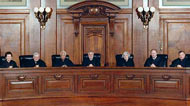D.U.I. undo Consultants, LLC
Helping Innocent People "PROVE" Their Innocence!

Field Sobriety Testing
One of the things DUI undo Consultants checks for in your DUI
discovery from the state is your performance on the video of the
standardized field sobriety tests (SFST), along with an analysis
of the officer's administration of the SFST''s according to the
National Highway Traffic & Safety Administration's (NHTSA)
guidelines. If the officer failed to instruct you per the NHTSA
guidelines you may have legal recourse as to the admissibility
of the FST as evidence against you.

DUIundo.com videos of DUI Checkpoints can be seen on
You Tube
Did you take an HGN test or perform the FST's at roadside?
Were you and the test videotaped at roadside?
Where you asked to recite the alphabet? Were you read your
Miranda Rights before you recited the alphabet?
Click here if you recited the Aphabet before you were informed
of your Miranda Rights.
Does the Law Enforcement Agency who arrested you have a
written DUI Arrest Policy and Procedure or a Mobile Video
Recording Policy and Procedure to videotape at roadside?
Defense Attorney's Link:
Statistical Evaluation of
Standardized Field Sobriety Tests
by:
Michael P. Hlastala,1 Ph.D.; Nayak L. Polissar,2 Ph.D.; and
Steven Oberman,3 J.D.
Click here to watch video of FST's
Clemson Study Field Sobreity Tests - Are
They Designed for Failure?
Decrease in Timed Balance Test Scores with
Aging
Field Sobriety Testing (FST) is a series of psychophysical
tests administered by law enforcement designed to determine if
an individual is Driving Under the Influence (DUI) or Driving
While Intoxicated (DWI) or More specifically, Field Sobriety
Testing (FST) is used to determine if an individual is under
the influence of alcohol.
Since the mid 1970's, the
National Highway Traffic Safety Administration (NHTSA) has
conducted research resulting in the creation of three
standardized field sobriety tests. Initially referred to as
Improved Sobriety Testing, these tests were further validated
by the Southern California Research Institute and relabeled
Standardized Field Sobriety Testing (SFST). The tests were
initially created by the Los Angeles Police Department
Training unit and are now the standard recommended by the
Federal Government through the NHTSA. A formal training
program has been developed and is available through the NHTSA
to aid police officers in becoming more skillful at detecting
suspects that may be Driving Under the Influence (DUI)
orDriving While Intoxicated (DWI).
The Standard Field Sobriety Test (SFST) consists of a battery
of three tests which are to be administered and evaluated in a
standardized manner in order to obtain validated indicators of
impairment and to establish probable cause for arrest.
The three tests administered are:
1. The Horizontal Gaze Nystagmus (HGN)
2. The Walk-and-Turn
3. The One-Leg Stand
Horizontal Gaze Nystagmus (HGN) Testing:
Click
here for video of HGN
HORIZONTAL GAZE NYSTAGMUS: THE SCIENCE & THE LAW
A Resource Guide for Judges, Prosecutors and Law Enforcement

Horizontal Gaze Nystagmus (HGN) is an involuntary jerking
movement of the eyeball that occurs naturally as an
individual's eye gazes to the side. Normally, nystagmus
(jerking movement) occurs when the eyes are rotated at high
peripheral angles. When an individual is impaired by the
effects of alcohol, this jerking is exaggerated and can occur
at lesser angles. Additionally, an individual Driving While
Intoxicated (DWI) or Driving Under the Influence (DUI) will
have greater difficulty tracking a moving object. As the test
is administered, law enforcement personnel look for three
indicators of impairment. The indicators are:
1.If the eye cannot follow a moving object smoothly.
2.If jerking is distinctly noticeable when the eye is looking
as far to the side as it can (maximum deviation).
3.If the jerking begins when the eye is within 45 degrees of
center.
The officer tests each eye. If, between both eyes, four or
more of the indicators are observed, research indicates that
approximately 77 percent of suspects will likely have a Blood
Alcohol Content (BAC) of .10 or higher.
Illinois Supreme Court Questions DUI Eye Test
Illinois Supreme Court rules that one of the key field
sobriety test used for decades has not been proved reliable.

The Illinois Supreme Court issued a ruling in September that
questioned the reliability of one of the key field sobriety
tests used to convict motorists of driving under the influence
(DUI) of alcohol. The high court found that the results of a
test known as horizontal gaze nystagmus should be open to
challenge in court as an unsettled matter. The state court of
appeals had earlier ruled that the principles underlying the
test could not be questioned.
Nystagmus is the abnormal and involuntary jerking of the
eyeballs as they track an object to the extreme range of their
motion. The jerking movement tends to occur earlier for those
who are either intoxicated or suffer from a number of
different ailments.
Joanne McKown failed this eye test when it was administered to
her in a hospital bed on June 8, 2002. She was then charged
with multiple counts of DUI and reckless driving. At around
11:30am, McKown 's car crossed the center line and struck
three motorcycles causing severe injuries. McKown admitted she
drank two beers before leaving her home, had one beer while
driving and was just about to start a fourth when the crash
happened.
A blood test taken at 6pm did not reveal the presence of
alcohol and McKown's broken toe precluded the usual one-leg
stand and walk-and-turn tests. McKown's conviction for DUI
rested substantially on the nystagmus test which she took
while under the influence of medication administered at the
hospital.
The Illinois Supreme Court in overturning the appeals court's
blanket approval of nystagmus noted that courts around the
country do not agree whether the test is accepted as reliable.
"The NHTSA has admitted that the 45-degree angle test is wrong
22 percent of the time," the high court wrote in its treatment
of prior case law.
The supreme court also recognized that research has found a
number of substances, including caffeine, nicotine or aspirin,
can cause reactions similar to alcohol that a highly trained
medical expert would have difficulty distinguishing from the
effects of intoxication. Embarrassingly, this argument came
from the prosecutions own material.
"At least one of the sources the state provides in the
appendix to its brief actually denounces the use of HGN
testing for roadside sobriety tests," the court wrote.
"The technical writings above reveal a dichotomy in the
scientific community, rather than the unequivocal or
undisputed viewpoint necessary for us to take judicial
notice," the court concluded. "As such, we cannot take
judicial notice of the general acceptance of the HGN test as a
reliable indicator of alcohol impairment based on these
technical writings.... we find that this issue cannot be
resolved in Illinois on judicial notice alone. "
California defense attorney Lawrence Taylor, who runs the
DUIBlog website suggests
this may not be the only field sobriety test that produces
questionable results.
"These tests are highly unreliable and largely used to justify
the officer's suspicions," Taylor wrote. "Although they are in
reality no more valid at determining intoxication than the
other tests, their adoption by the federal government has
given them an aura of credibility."
The supreme court did not find McKown innocent. Rather, it
ordered the trial court to conduct an extensive evidentiary
hearing to establish the reliability of the nystagmus test.
The full court opinion is available in a 180k PDF file at the
source link below.
Source:
Illinois v. McKown (Supreme Court of the State of
Illinois, 9/20/2007)
Divided Attention Testing
Your Ability to Listen and
Preform these Test per Instructions Determines if YOU PASS OR
FAIL.
(My mother used to tell me to put my right hand over my right
ear so things wouldn't go in one ear and out the other. I
suggest that if you are asked to perform FST's and you have
difficulties in following directions, that you put one hand
over one of your ears)
The Walk-and-Turn test and the One-Leg Stand test are both
"divided attention" tests that are easy to perform by most
sober individuals. The goal of divided attention tests is to
require an individual to both listen and follow instructions
while performing simple physical movements. The State and
NHTSA want you to believe that individuals who are Driving
While Intoxicated (DWI) or Driving Under the Influence (DUI)
will typically have more difficulty completing these tasks
than an individual who is not impaired.
Click here for
more information on those facts.
Walk-and-Turn Test
In the Walk-and-Turn test, the individual is instructed to
take nine steps, heel-to-toe, along a straight line. After
taking the steps, the individual is instructed to turn on one
foot and return in the same manner along the original path.
There are seven indicators of impairment for this test. The
indicators are:
1.If the individual cannot maintain balance while listening to
the instructions.
2.If the individual begins before instructions are finished.
3.If the individual stops while walking to regain balance.
4.If the individual does not touch heel-to-toe.
5.If the individual uses arms to balance.
6.If the individual loses balance while turning.
7.If the individual takes an incorrect number of steps.
Research indicates that 68 percent of individuals that
demonstrate two or more of these indicators will have a Blood
Alcohol Content (BAC) of .10 or higher.
One-Leg Stand Test
In the One-Leg Stand Test, an individual is instructed to
stand with one foot approximately six inches off the ground
and count aloud in thousands until instructed by law
enforcement personnel to put the foot down. The individual is
timed for thirty seconds. There are four indicators looked for
during this test. The indicators are:
1.If the individual sways while balancing.
2.If the individual uses their arms to balance.
3.If the individual hops to maintain balance.
4.If the individual puts the foot down.
NHTSA research indicates that if two or more indicators are observed
there is a 65 percent chance that the individual has a Blood
Alcohol Content (BAC) of .10 or greater.
Effectiveness of Field Sobriety Testing in Court Testimony
The effectiveness of Field Sobriety Testing in court testimony
depends largely on the total number of indicators observed
during the three tests. If many indicators were observed
during each of the three tests, the higher the effectiveness
of the testimony. If the Field Sobriety Testing was
administered according to national standards, it has greater
credibility than purely subjective testimony. Only a qualified
and competent Gladiator DUI - DWI Defense Attorney can
effectively assist in determining if the test was properly
administered and build a solid defense to defend against
incorrect administration or interpretation of the test
results.
"Why Call DUI undo?"
Because you can't undo what you don't know how to do.
